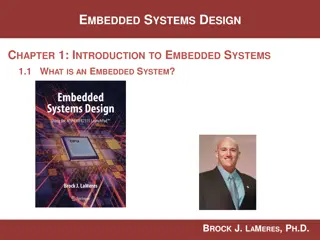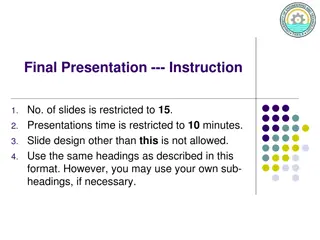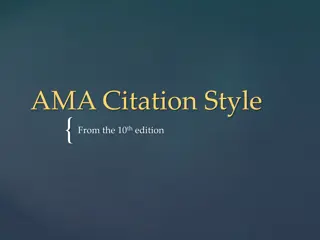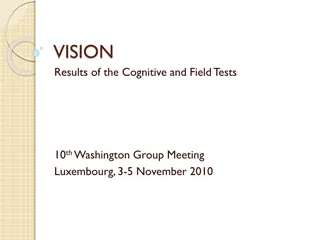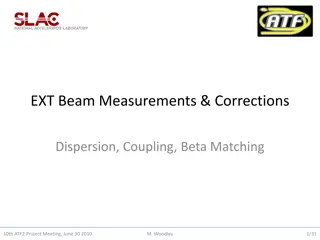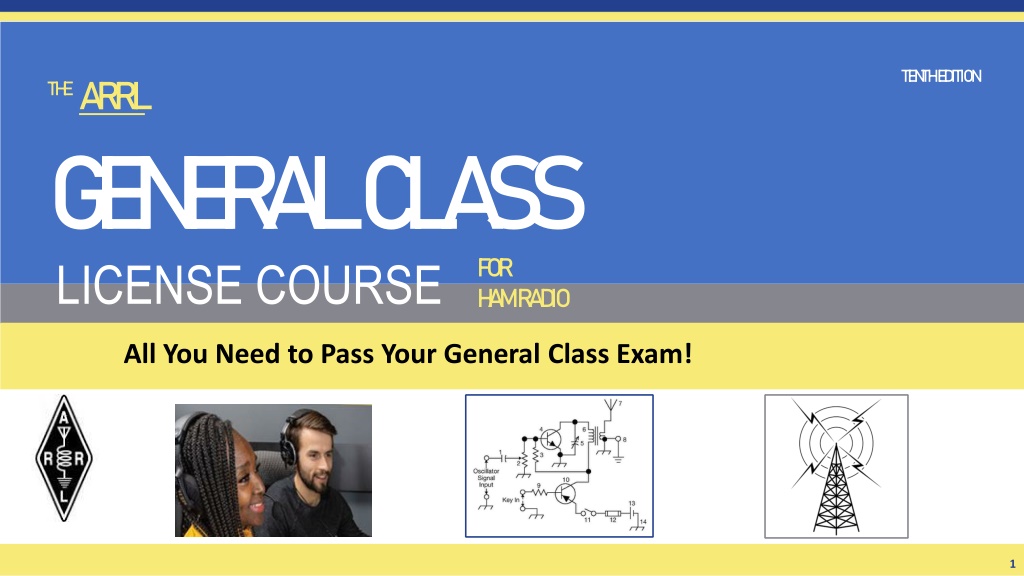
Pass Your General Class Exam with TE.N.TH.E.D.ITION
"Prepare for your General Class exam with TE.N.TH.E.D.ITION book, covering essential topics like amplitude modulation, frequency modulation, and bandwidth definitions. Enhance your knowledge to succeed in the exam!"
Download Presentation

Please find below an Image/Link to download the presentation.
The content on the website is provided AS IS for your information and personal use only. It may not be sold, licensed, or shared on other websites without obtaining consent from the author. If you encounter any issues during the download, it is possible that the publisher has removed the file from their server.
You are allowed to download the files provided on this website for personal or commercial use, subject to the condition that they are used lawfully. All files are the property of their respective owners.
The content on the website is provided AS IS for your information and personal use only. It may not be sold, licensed, or shared on other websites without obtaining consent from the author.
E N D
Presentation Transcript
TE N TH E D ITION TH EA RRL G E N E R A L C L A SS LICENSE COURSE FOR H A M R A D IO All You Need to Pass Your General Class Exam! 1
Resource & Reference www.arrl.org/shop/Licensing-Education-and-Training 2
Chapter 5 Part 1 of 2 ARRL General Class Radio Signals & Equipment Sections 5.1, 5.2, 5.3 Basic Modes & Bandwidth, Radio s Building Blocks, Transmitters 3
Section 5.1 Basic Modes & Bandwidth: Amplitude Modulated Modes Varying the power or amplitude of a signal to add speech or data is called amplitude modulation (AM) This info contained in the signal s envelope the max values of the instantaneous power for each cycle The process of recovering speech or music from the AM envelope is called detection AM signals are composed of a carrier and two sidebands (upper and lower USB and LSB) 4
Amplitude Modulated Modes (cont.) When an AM signal is modulated by a tone, the two sidebands are steady and unchanging (as long as the tone is transmitted) Upper sideband is higher in frequency than the carrier; lower sideband is lower in frequency than carrier AM signal with the carrier and one sideband removed is a single sideband signal (SSB) SSB transmissions have more range than AM because all the SSB s power is contained in a single sideband. The SSB s smaller bandwidth makes it possible to fit more signals in a fixed frequency range. 5
Frequency & Phase Modulated Modes Modes that vary the frequency of a signal to add speech or data info are called frequency modulation (FM) Frequency is varied in proportion to the instantaneous amplitude of the modulating signal Phase modulation (PM) is created by varying the signal s phase angle These signals have a constant power, whether modulated or not 6
Bandwidth Definition Figure 5.1: The FCC defines bandwidth as the width of a frequency band outside of which the mean [average] power of the transmitted signal is attenuated at least 26 dB below the mean power. 7
Bandwidth Definition (cont.) The difference in frequency between the lowest and highest component of a composite signal is the signal s bandwidth See Fig 5.1 for the FCC definition (previous slide) The FCC limits signal bandwidth so that many stations and types of signals can share the limited amount of spectrum space (see Table 5.1, next slide) 8
Table 5.1: Amateur Signal Bandwidths Most Common Amateur Signals Type of Signal Typical Bandwidth AM voice 6 kHz Amateur television 6 MHz SSB voice 2 to 3 kHz Digital using SSB 50 to 3000 Hz (0.05 3 kHz) CW 100 to 300 Hz (0.1 0.3 kHz) FM voice 5 to 16 kHz 9
Link Budgets Telecommunications term that accounts for all the power gains and losses a signal experiences within a system In amateur radio, this is generally the transmit power and antenna gains from the sending station minus any system losses the receiving station experiences Losses result from ionospheric refraction, attenuation, or a variety of other causes Link margin (LKM) is the difference between the minimum power level needed to receive a signal and the actual power level of the received signal (measured in dB) 10
What is the name of the process that changes the phase angle of an RF signal to convey information? A. Phase convolution B. Phase modulation C. Phase transformation D. Phase inversion G8A02 (B) Page 5-2 12
What is the name of the process that changes the instantaneous frequency of an RF wave to convey information? A. Frequency convolution B. Frequency transformation C. Frequency conversion D. Frequency modulation G8A03 (D) Page 5-2 13
What type of modulation varies the instantaneous power level of the RF signal? A. Power modulation B. Phase modulation C. Frequency modulation D. Amplitude modulation G8A05 (D) Page 5-2 14
Which of the following phone emissions uses the narrowest bandwidth? A. Single sideband B. Vestigial sideband C. Phase modulation D. Frequency modulation G8A07 (A) Page 5-2 15
What is a link budget? A. The financial costs associated with operating a radio link B. The sum of antenna gains minus system losses C. The sum of transmit power and antenna gains minus system losses as seen at the receiver D. The difference between transmit power and receiver sensitivity G8A13 (C) Page 5-3 16
What is link margin? A. The opposite of fade margin B. The difference between received power level and minimum required signal level at the input to the receiver C. Transmit power minus receiver sensitivity D. Receiver sensitivity plus 3 dB G8A14 (B) Page 5-3 17
Section 5.2 Radio s Building Blocks Nearly all radios are made up of a few fundamental types of circuits There s a variety of ways circuits are built, but basic functions are the same Radio circuits that perform signal generating & processing functions can also be performed on digital data by software in a radio that uses digital signal processing (DSP) referred to as software-defined radio (SDR) 18
Filters Used to attenuate (reduce in strength) or pass signals Classified by their response (how they act on signals) Range of signals passes is the passband Range of signals attenuated is the stopband (attenuation is also referred to as rejection) 19
Figure 5.2 Generic filter response curves showing how filters of different types affect signals. A larger filter response means less attenuation of the signal cutoff frequencies are shown as fCO. The cutoff frequency is the frequency at which the output signal power is reduced to one-half that of the input signal. Above a low-pass filter s cutoff frequency, the attenuation generally increases with frequency. 20
Figure 5.2 Generic filter response curves showing how filters of different types affect signals. A larger filter response means less attenuation of the signal cutoff frequencies are shown as fCO. The frequency range between the upper and lower cutoff frequencies is the filter s bandwidth. 21
Filters (cont.) Low-pass filters (Fig 5.2A) pass all frequencies below the cutoff frequency with little or no attenuation. The cutoff frequency (fCO) is the frequency at which the output signal power is reduced to one-half that of the input signal. High-pass filter (Fig 5.2B) is the opposite; signals are passed above the cutoff frequency and attenuated below. 22
Filters (cont.) Band-pass filters have upper and lower cutoff frequencies. Signals between these are passed outside are attenuated. Frequency range between upper and lower cutoff is the filter s bandwidth Opposite of band-pass is band-stop (attenuates signals between cutoff frequencies) narrow stopbands are called notch filters Even though filters pass a range of frequencies, they may attenuate signals in the passband. This is called insertion loss. Outside passband, attenuation may vary, but maximum attenuation is the filter s ultimate rejection. 23
Oscillators Fig 5.3: An oscillator consists of an amplifier with feedback from the output to input. The product of gain and feedback ratio must be greater than 1 at the frequency of oscillation. 24
Oscillators (cont.) An oscillator consists of an amplifier that increases signal amplitude (gain) and a feedbackcircuit to route some of the amplifier s output signal back to its input Oscillator circuits must include a filter so that feedback is present at only the intended frequency The oscillator output frequency can be fixed or variable 25
Oscillators (cont.) LC oscillator s feedback circuits consist of an inductor (L) and capacitor (C) connected (in parallel or series) to form a resonant circuit Often called a tank circuit because of their ability to store energy The resonant frequency of the LC circuit (determined by the L and C values) is the frequency of the oscillator The output frequency of a variable-frequency oscillator (VFO) can be adjusted by changing the L or C. VFOs are used to tune a radio to different frequencies. 26
Oscillators (cont.) Two other widely used VFO circuits are Phase-locked loop (PLL) Direct digital synthesizer (DDS) Controllable by software Comparable stability to crystal oscillators Used as the high-stability VFO in most current transceivers 27
Mixers Mixers change signals to another frequency A mixer circuit combines signals with two frequencies, f1 and f2, and produces signals with the sum and difference frequencies at its output (heterodyning) Example f1 = 14.050 MHz f2 = 3.35 MHz There will be output signals at 17.4 (f1 + f2) and 10.7 (f1 f2) MHz Fig 5.4: The mixer combines signals of different frequencies, producing signals at the sum and difference frequencies. 28
Multipliers (see Fig 5.5 in text) Similar to a mixer Creates a harmonic of an input frequency Multipliers are often used when a stable VHF or UHF signal is required that cannot be generated directly at VHF/UHF A low-frequency oscillator supplies the multiplier input, and the output is tuned to the desired harmonic of the input signal Also used in FM transmitters (covered later) 29
Modulators Add info to a carrier signal by varying the carrier s amplitude, frequency, or phase Can be used for AM, FM, or SSB 30
Amplitude Modulation Figure 5.6: The spectrum of 3 types of AM signals. Full AM has both sidebands and the carrier. The carrier is represented by the vertical line in the middle, and the sidebands contain speech or data signals that have been used to modulate the carrier. DSB removes the carrier, but has the same bandwidth as full AM. SSB removes one sideband and has the lowest bandwidth of the 3. 31
Amplitude Modulation (cont.) DSB can be produced by a balanced modulator special mixer where f1 is the carrier and f2 is the modulator SSB is generated by removing the unwanted sideband and carrier with a filter (filter method) or by combining signals with certain phase relationships (phasing method) Using only one sideband uses transmitted output power more effectively 32
Frequency & Phase Modulation: Figure 5.7 (A) FREQUENCY MODULATION 33
Frequency & Phase Modulation: Figure 5.7 (B) PHASE MODULATION 34
Frequency & Phase Modulation (cont.) Frequency modulation (FM) the signal frequency varies in proportion to modulating signal s amplitude called deviation Phase modulation (PM) deviation varies with both amplitude and frequency of the modulating signal produced by a reactance modulator connected to a tuned RF amplifier following the oscillator When modulation is applied, the phase of the carrier will be changed, but the average frequency will NOT change Sound identical on the air 35
Quadrature Modulation Also called I/Q modulation because of the I & Q signals that create the modulated output signal Used to transmit digital data, but different combinations of I & Q signals can create signals with any form of modulation The RF output of the combiner consists of a pair of modulated signals that have carrier signals 90 different in phase Widely used in software-defined radios (SDR) where traditional analog components have been replaced by programming (e.g., filtering, modulation, detection, etc.) Fig 5.8: Block diagram of an I/Q modulator. I & Q are designators for input signals that can be analog signals or streams of digital data. Quadrature simply means phase-shifted by 90 degrees. 36
Which of the following are basic components of a sine wave oscillator? A. An amplifier and a divider B. A frequency multiplier and a mixer C. A circulator and a filter operating in a feed-forward loop D. A filter and an amplifier operating in a feedback loop G7B07 (D) Page 5-5 38
What determines the frequency of an LC oscillator? A. The number of stages in the counter B. The number of stages in the divider C. The inductance and capacitance in the tank circuit D. The time delay of the lag circuit G7B09 (C) Page 5-5 39
Which of the following is characteristic of a direct digital synthesizer (DDS)? A. Extremely narrow tuning range B. Relatively high-power output C. Pure sine wave output D. Variable output frequency with the stability of a crystal oscillator G7C05 (D) Page 5-5 40
What term specifies a filters attenuation inside its passband? A. Insertion loss B. Return loss C. Q D. Ultimate rejection G7C07 (A) Page 5-5 41
What is the phase difference between the I and Q RF signals that software-defined radio (SDR) equipment uses for modulation and demodulation? A. Zero B. 90 degrees C. 180 degrees D. 45 degrees G7C09 (B) Page 5-7 42
What is an advantage of using I-Q modulation with software- defined radios (SDRs)? A. The need for high resolution analog-to-digital converters is eliminated B. All types of modulation can be created with appropriate processing C. Minimum detectible signal level is reduced D. Automatic conversion of the signal from digital to analog G7C10 (B) Page 5-7 43
Which of these functions is performed by software in a software- defined radio (SDR)? A. Filtering B. Detection C. Modulation D. All these choices are correct G7C11 (D) Page 5-4 44
What is the frequency above which a low-pass filters output power is less than half the input power? A. Notch frequency B. Neper frequency C. Cutoff frequency D. Rolloff frequency G7C12 (C) Page 5-4 45
What term specifies a filters maximum ability to reject signals outside its passband? A. Notch depth B. Rolloff C. Insertion loss D. Ultimate rejection G7C13 (D) Page 5-5 46
The bandwidth of a band-pass filter is measured between what two frequencies? A. Upper and lower half-power B. Cutoff and rolloff C. Pole and zero D. Image and harmonic G7C14 (A) Page 5-4 47
What emission is produced by a reactance modulator connected to a transmitter RF amplifier stage? A. Multiplex modulation B. Phase modulation C. Amplitude modulation D. Pulse modulation G8A04 (B) Page 5-7 48
What is another term for the mixing of two RF signals? A. Heterodyning B. Synthesizing C. Frequency inversion D. Phase inversion G8B03 (A) Page 5-5 49
What is the stage in a VHF FM transmitter that generates a harmonic of a lower frequency signal to reach the desired operating frequency? A. Mixer B. Reactance modulator C. Balanced converter D. Multiplier G8B04 (D) Page 5-6 50









